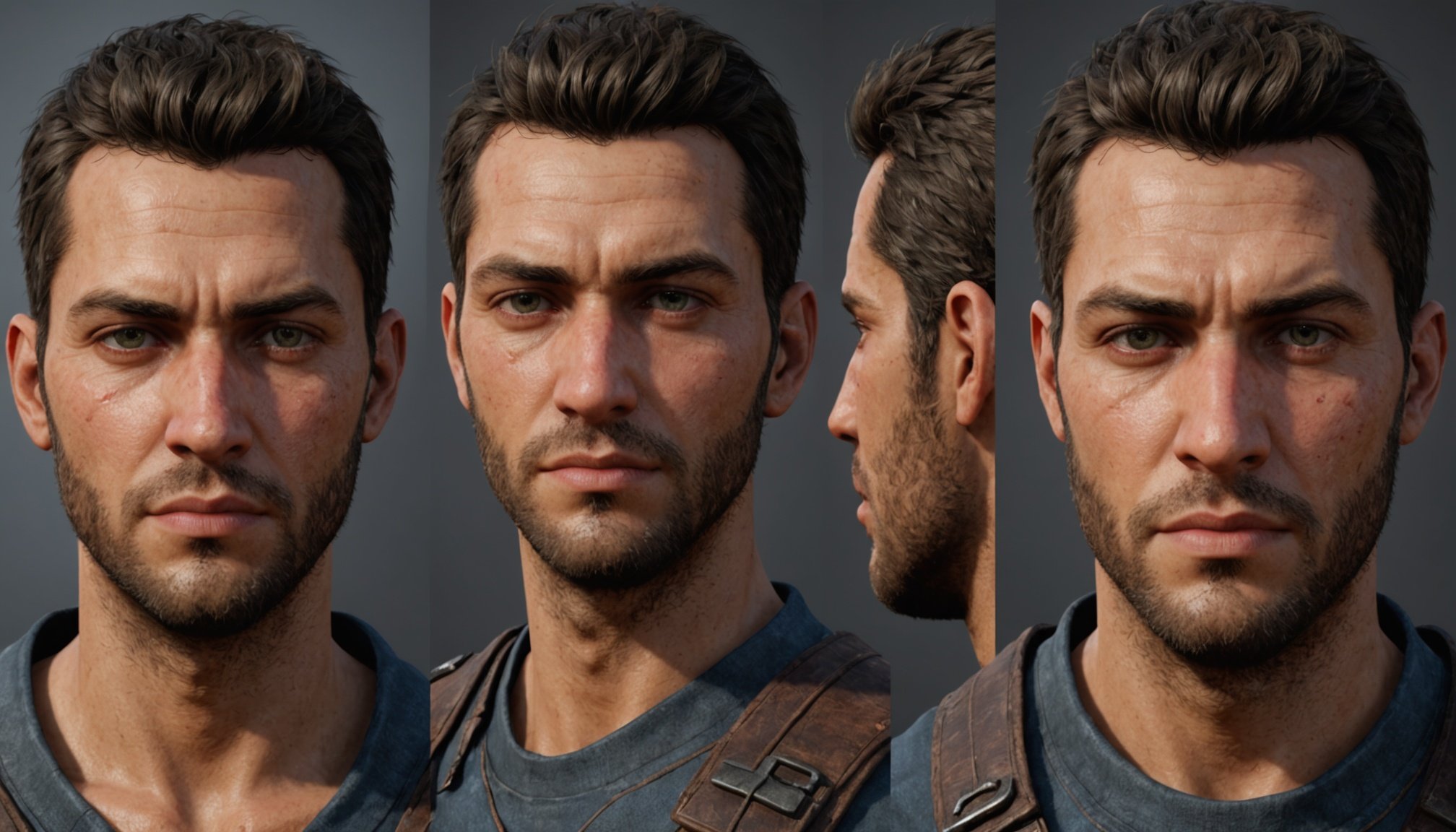Unlocking Photorealistic Character Textures: Proven Techniques for Next-Gen Gaming Mastery
In the ever-evolving world of gaming, achieving photorealistic character textures is a holy grail for developers and artists alike. With the advent of next-gen technologies, the bar for visual fidelity has been raised significantly. Here, we delve into the proven techniques and cutting-edge tools that are redefining the art of creating realistic character textures in modern gaming.
The Importance of Realistic Textures in Gaming
Realistic textures are more than just a visual enhancement; they are crucial for immersing players in the game world. As László Hackl notes in his work on the Metro Mask project, “Realistic textures bring to life your 3D models. It enhances the experience of the player by giving the game world a reality feel”[3].
Have you seen this : Essential Elements for Crafting an Intuitive Inventory System in Complex RPGs
Phase 1: Research and Reference Gathering
The foundation of any photorealistic character texture project begins with thorough research and reference gathering. Adán Pérez, in his detailed breakdown of creating Homelander’s 3D portrait, emphasizes the importance of high-resolution photographic references. He used images from platforms like Getty Images, focusing on close-ups and portraits of Antony Starr, the actor portraying Homelander. These references were organized in PureRef, a tool essential for managing visual references throughout the sculpting process[1].
Key Steps in Research and Reference Gathering
- High-Quality Reference Images: Gather high-resolution images from reliable sources.
- Organize References: Use tools like PureRef to manage and access references easily.
- Focus on Details: Pay attention to facial features, skin textures, and other key details.
Phase 2: Sculpting and Base Model Creation
Sculpting the base model is where the magic begins. Tools like ZBrush and Blender are indispensable in this phase. Adán Pérez used ZBrush to sculpt the base model of Homelander, focusing on recreating the bone structure and facial proportions of Antony Starr. For a seamless integration with textures, he utilized FaceBuilder in Blender to create a 3D mesh of the face based on reference images[1].
In the same genre : Mastering the Art of Seamless Gameplay: Innovative Strategies for Effortless Transitions Between VR and Traditional Gaming Experiences
Tools and Techniques for Sculpting
- ZBrush: Ideal for achieving high detail in facial features.
- FaceBuilder: Helps in creating a 3D mesh that fits perfectly with the sculpture.
- XYZ Texturing Bases: Use high-resolution maps with cavity and displacement details to enhance texture quality.
Phase 3: Texture Painting and Detailing
Texture painting is a critical phase where the character’s skin, clothing, and other details come to life. Mari, a tool specialized in painting textures for high-resolution models, is often used in this stage. Adán Pérez integrated XYZ maps and FaceBuilder geometry in Mari to enhance texture quality. He also generated an additional cavity map layer to add depth to the details, similar to a Displacement Map extracted from ZBrush[1].
Techniques for Texture Painting
- Use High-Quality Maps: Integrate XYZ maps and other high-resolution textures.
- Add Depth with Cavity Maps: Enhance details by adding cavity map layers.
- Balance Realism: Carefully balance the realism of skin, clothing, and other key details.
Phase 4: Shader Creation and Lighting
Shader creation is where the textures meet the light, bringing the character to life. In Maya, Adán Pérez worked on shaders for Homelander’s skin, eyes, and clothing. This phase involved refining the facial mesh and seeking help from experts like Amirhosein Sajadi to design the eyes, achieving a more lifelike expression[1].
Key Aspects of Shader Creation
- Refine Facial Mesh: Make adjustments to ensure realistic proportions.
- Collaborate on Details: Seek expertise for critical features like eyes.
- Use Advanced Tools: Utilize tools like Maya for creating realistic skin shaders.
Phase 5: Grooming and Final Touches
Grooming is a crucial aspect, especially for characters with distinctive hair styles. For Homelander, Adán Pérez collaborated with Latif Fajrin, an expert in CGI grooming, to create photorealistic hair using XGen in Maya. This collaboration was essential in achieving the final, polished look of the character[1].
Techniques for Grooming
- Collaborate with Experts: Work with specialists in grooming for realistic hair effects.
- Use Advanced Tools: Tools like XGen in Maya can create highly realistic hair textures.
- Attention to Detail: Ensure that the hair style aligns perfectly with the character’s design.
The Role of Next-Gen Technologies in Realistic Textures
Next-gen technologies are revolutionizing the way we create and experience realistic textures in gaming.
Ray Tracing
Ray tracing is a groundbreaking technology that simulates the natural behavior of light, producing stunningly realistic visuals. Games like Cyberpunk 2077 and Minecraft RTX demonstrate the transformative impact of ray tracing, offering environments where light behaves as it would in the real world—reflecting off surfaces, casting realistic shadows, and interacting dynamically with objects[4].
Benefits of Ray Tracing
- Accurate Light Behavior: Simulates how light interacts with objects in a scene.
- Enhanced Visual Fidelity: Creates accurate reflections, shadows, and global illumination.
- Artistic Possibilities: Allows developers to craft intricate scenes that evoke emotion and draw players deeper into their narratives.
AI and Machine Learning
AI and machine learning are reshaping the gaming landscape by introducing smarter rendering techniques and dynamic environments. NVIDIA’s DLSS (Deep Learning Super Sampling) is a prime example, using AI to upscale lower-resolution images into high-quality visuals with minimal performance impact[4].
Applications of AI in Game Graphics
- Texture Generation: GANs can generate realistic textures for surfaces, enhancing visual fidelity.
- Character Design: AI can create unique character designs that fit within the game’s aesthetic.
- Procedural Generation: AI-driven systems can automatically create vast, complex worlds that evolve in real-time.
Photogrammetry
Photogrammetry is a technique that uses real-world data to create hyper-realistic digital assets. By scanning physical objects and environments, developers capture intricate details like textures, shapes, and imperfections, translating them into virtual assets that closely mirror reality[4].
Benefits of Photogrammetry
- Unparalleled Accuracy: Eliminates the need for manual modeling, ensuring high accuracy.
- Realistic Environments: Brings a new level of immersion to gaming by creating lifelike worlds.
- Efficiency: Reduces the workload for developers while ensuring high-quality assets.
Practical Insights and Actionable Advice
High-Quality Reference Images
Always start with high-quality reference images. Whether you are capturing textures of wood, metal, fabric, or stone, good images guide your work and ensure your materials look lifelike[2].
UV Mapping Your Model
UV mapping is crucial before applying textures. In Blender, switch to “UV Editing” mode and unwrap the model to create the 2D layout of your 3D surface. This ensures that your textures wrap around your model correctly[2].
Experiment with Procedural Textures
Procedural textures in Blender allow you to generate textures without importing external files. Use nodes like “Noise Texture” or “Voronoi Texture” to create patterns like wood grain or marble. Adjust parameters such as scale and detail to customize the texture[2].
Bake Textures for Efficiency
Baking textures combines all texture maps into one file that game engines can process quickly. This step is essential in game development as it optimizes textures without reducing quality[2].
Tools and Software for Next-Gen Textures
Blender
Blender is a versatile tool that can achieve realistic textures. It offers features like UV mapping, procedural textures, and texture painting, making it a go-to software for both beginners and professionals[2].
Maya
Maya is a powerful tool for shader creation and lighting. It allows for refining facial meshes and creating realistic skin shaders, which are essential for photorealistic characters[1].
ZBrush
ZBrush is ideal for sculpting high-detail models. It is particularly useful for facial features and other intricate details that require precision[1].
Mari
Mari is specialized in painting textures for high-resolution models. It allows for integrating high-quality maps and adding depth to details, making it a crucial tool in the texture painting phase[1].
Creating photorealistic character textures is a multifaceted process that involves meticulous research, advanced sculpting, detailed texture painting, and the use of next-gen technologies. By leveraging tools like Blender, Maya, ZBrush, and Mari, and incorporating techniques such as ray tracing, AI, and photogrammetry, developers can achieve textures that are not only visually stunning but also deeply immersive.
As Adán Pérez reflects on his project, “Thanks to the recent course by Şefki Ibrahim, I was able to improve various areas of my technique, especially regarding realistic modeling and texture integration. His teachings were key to achieving the quality level in this model”[1].
In the world of next-gen gaming, the pursuit of photorealism is ongoing, and with the right tools, techniques, and a bit of creativity, developers can unlock new levels of visual fidelity that redefine the gaming experience.
Table: Comparison of Key Tools for Photorealistic Textures
| Tool | Key Features | Best For |
|---|---|---|
| Blender | UV mapping, procedural textures, texture painting | Beginners and professionals in game design and animation |
| Maya | Shader creation, lighting, refining facial meshes | Advanced shader creation and lighting |
| ZBrush | High-detail sculpting, facial features | Sculpting intricate details and facial features |
| Mari | Texture painting for high-resolution models, integrating high-quality maps | Detailed texture painting and adding depth to details |
| AI Models | Generative AI techniques, GANs, diffusion models | Automating texture generation, procedural generation, and real-time rendering |
Detailed Bullet Point List: Steps to Achieve Photorealistic Textures
- Research and Reference Gathering:
- Gather high-resolution photographic references.
- Organize references using tools like PureRef.
- Focus on key details like facial features and skin textures.
- Sculpting and Base Model Creation:
- Use ZBrush for high-detail sculpting.
- Utilize FaceBuilder in Blender for creating a 3D mesh.
- Integrate XYZ texturing bases for enhanced texture quality.
- Texture Painting and Detailing:
- Use Mari for painting textures and integrating high-quality maps.
- Add depth with cavity map layers.
- Balance realism in skin, clothing, and other details.
- Shader Creation and Lighting:
- Refine facial meshes using ZBrush.
- Collaborate with experts for critical features like eyes.
- Use Maya for creating realistic skin shaders.
- Grooming and Final Touches:
- Collaborate with experts in CGI grooming.
- Use tools like XGen in Maya for realistic hair textures.
- Ensure the hair style aligns perfectly with the character’s design.
- Next-Gen Technologies:
- Implement ray tracing for accurate light behavior.
- Use AI and machine learning for smarter rendering techniques and dynamic environments.
- Utilize photogrammetry for hyper-realistic digital assets.
By following these steps and leveraging the latest tools and technologies, developers can unlock the secrets to creating photorealistic character textures that elevate the gaming experience to new heights.








